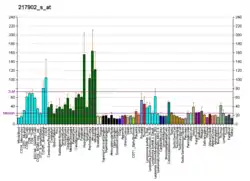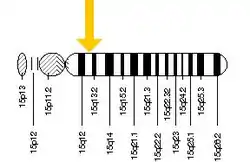E3 ubiquitin ligase HERC2
HERC2 is a giant E3 ubiquitin protein ligase, implicated in DNA repair regulation, pigmentation and neurological disorders. It is encoded by a gene of the same name belonging to the HERC family, which typically encodes large protein products with C-terminal HECT domains and one or more RCC1-like (RLD) domains.[5][6]
History
HERC2, previously referred to as the rjs gene locus, was first identified in 1990 as the gene responsible for two phenotypes in mice: the runty, jerky, sterile (rjs) phenotype and the juvenile development and fertility-2 (Jdf2) phenotype. Mutant alleles are known to cause hypo-pigmentation and pink eye phenotypes, as well reduced growth, jerky gait, male sterility, female semi-sterility, and maternal behaviour defects in mice.[7][8][9]
Gene locus
The full HERC2 gene is located at 15q13, encoded by 93 exons and its transcription is under the control of a CpG rich promoter. This region on chromosome 15 is susceptible to breaks during chromosomal rearrangement and there are at least 12 partial duplicates of HERC2 between 15q11–15q13.[10]
At least 15 HERC2 SNPs have been identified and they are strongly associated with human iris colour variability, functioning to repress expression of OCA2's product.[11]
Protein structure
HERC2 encodes a 4834-amino acid protein with a theoretical size of 528 kDa. While a full structure has not yet been elucidated, potentially due to its large size, partial structures of its domains have been captured.[12]
It has an N-terminal bilobed HECT domain, conferring E3 ligase functionality, as well as 3 RLD domains with seven-bladed β-propeller folds. In addition to these HERC family hallmarks, it has several other motifs; a cytochrome-b5-like domain, several potential phosphorylation sites, and a ZZ-type zinc finger motif.[5] This is likely involved in protein binding, and has recently been identified as a SUMOylation target following DNA damage.[13]
Expression of HERC2 is ubiquitous, though particularly high in the brain and testes. Cellular localisation is predominantly to the nucleus and cytoplasm.[5]
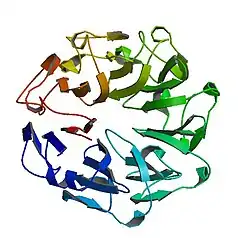
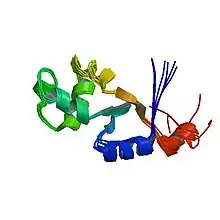
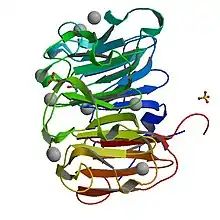
Protein function
Pigmentation
SNPs of HERC2 are strongly associated with iris colour variability in humans. In particular, the rs916977 and rs12913832 SNPs have been reported as good predictors of this trait, and the latter is also significantly associated with skin and hair colour. The ancestral allele is linked to darker pigmentation and dominant over the lighter pigment recessive allele.[14][15] The rs12913832 SNP, located in intron 86 of the HERC2 gene contains a silencing sequence that can inhibit the expression of OCA2 and, if both recessive alleles are present, can homozygously cause blue eyes.[16] This genotype is present in almost all people with blue eyes and is hypothesised as being the founder mutation of blue eyes in humans.[17][18][19]
The rs916977 SNP is most common in Europe; particularly in the north and east, where it nears fixation. The variant is also found at high frequencies in North Africa, the Near East, Oceania and the Americas.[20]
DNA repair pathways
HERC2 is a component of the replication fork and essential for DNA damage repair pathways. Regulating DNA repair pathways is necessary, as unchecked they can target and excise undamaged DNA, potentially leading to mutation.[21]
It is involved in coordinating the Chk1-directed DNA damage/cell cycle checkpoint response by regulating the stability of the deubiquitination enzyme USP20. Under normal conditions HERC2 associates with USP20 and ubiquitinates it for degradation. Under replication stress, for example a DNA polymerase mismatch error, USP20 disassociates from HERC2 and deubiquitinates claspin, stabilising it to then bind and activate Chk1. This allows for DNA replication to be paused and the error corrected.[22][23][24]
At the site of doubles stranded breaks, HERC2 facilitates the binding of RNF8, a RING finger ubiquitin ligase to the E2 ubiquitin-conjugating enzyme UBC13. This association is required for RNF8 mediated Lys-63 poly-ubiquitination signalling, which both recruits and retains repair factors at the site of DNA damage to commence homologous recombination repair.[25]
HERC2 is also involved in regulating nucleotide excision repair by ubiquitinating the XPA repair protein for proteolysis. XPA is involved in recognising DNA damage and provides a scaffold for other repair factors to bind at the damage site.[26][27]
Centrosome assembly
HERC2 has been implicated in regulating stable centrosome architecture in conjunction with NEURL4 other ubiquitinated binding partners. Its absence is associated with aberrant centrosome morphology.[28]
Iron metabolism
HERC2 has recently been associated with regulating iron metabolism through ubiquitinating the F-box and leucine-rich repeat protein 5 (FBXL5) for proteasomal degradation. FBXL5 regulates the stability of the iron regulatory protein (IR2), which in turn controls the stability of proteins overlooking cellular iron homeostasis. Depletion of HERC2 results in decreased cellular iron levels. Iron is an essential nutrient in cells, but high levels can be cytotoxic, so maintaining cellular levels is important.[29]
Clinical significance
The 15q11-q13 locus of HERC2 is also associated with Angelman syndrome (AS), specifically when a region of this locus is deleted. Similar to the rjs phenotype attributed to HERC2 in mice, AS is associated with seizures, developmental delay, intellectual disability and jerky movements. While a variety of disturbances to this locus can cause AS, all known mechanisms affect the functioning and expression of the E6AP E3 ligase, which also sits at this locus. HER2 is an allosteric activator of E6AP, and lies at the most commonly deleted region in AS.[31] Its deletion could result in the inactivation of E6AP and consequently the development of AS.[32]
In Old Order Amish families, a homozygous proline to leucine missense mutation within the first RLD domain has been implicated in a neurodevelopmental disorder with autism and features resembling AS.[33] In addition, a homozygous deletion of both OCA2 and HERC2 genes was recently reported as presenting with severe developmental abnormalities.[34] These phenotypes are suggestive of a role for HERC2 in normal neurodevelopment.
Certain alleles of HERC2 has recently been implicated in increasing the risk of iris cancer. Due its role in pigment determination, three HERC2 SNPs have been highlighted as associated with uveal melanoma.[35] HERC2 frameshift mutations have also been described in colorectal cancers.[36]
In accordance to its role in facilitating p53 oligomerization, HERC2 may be causally related to Li-Fraumeni syndrome and Li-Fraumeni-like syndromes, which occur in the absence of sufficient p53 oligomerization.[30]
Interactions
HERC2 is known to interact with the following:
References
- ENSG00000276802, ENSG00000277278 GRCh38: Ensembl release 89: ENSG00000128731, ENSG00000276802, ENSG00000277278 - Ensembl, May 2017
- GRCm38: Ensembl release 89: ENSMUSG00000030451 - Ensembl, May 2017
- "Human PubMed Reference:". National Center for Biotechnology Information, U.S. National Library of Medicine.
- "Mouse PubMed Reference:". National Center for Biotechnology Information, U.S. National Library of Medicine.
- Sánchez-Tena S, Cubillos-Rojas M, Schneider T, Rosa JL (May 2016). "Functional and pathological relevance of HERC family proteins: a decade later". Cellular and Molecular Life Sciences. 73 (10): 1955–68. doi:10.1007/s00018-016-2139-8. PMID 26801221.
- Hochrainer K, Mayer H, Baranyi U, Binder B, Lipp J, Kroismayr R (February 2005). "The human HERC family of ubiquitin ligases: novel members, genomic organization, expression profiling, and evolutionary aspects". Genomics. 85 (2): 153–64. doi:10.1016/j.ygeno.2004.10.006. PMID 15676274.
- Lehman AL, Nakatsu Y, Ching A, Bronson RT, Oakey RJ, Keiper-Hrynko N, Finger JN, Durham-Pierre D, Horton DB, Newton JM, Lyon MF, Brilliant MH (August 1998). "A very large protein with diverse functional motifs is deficient in rjs (runty, jerky, sterile) mice". Proceedings of the National Academy of Sciences of the United States of America. 95 (16): 9436–41. doi:10.1073/pnas.95.16.9436. PMC 21356. PMID 9689098.
- Ji Y, Walkowicz MJ, Buiting K, Johnson DK, Tarvin RE, Rinchik EM, Horsthemke B, Stubbs L, Nicholls RD (March 1999). "The ancestral gene for transcribed, low-copy repeats in the Prader-Willi/Angelman region encodes a large protein implicated in protein trafficking, which is deficient in mice with neuromuscular and spermiogenic abnormalities". Human Molecular Genetics. 8 (3): 533–42. doi:10.1093/hmg/8.3.533. PMID 9949213.
- Brilliant MH (1992). "The mouse pink-eyed dilution locus: a model for aspects of Prader-Willi syndrome, Angelman syndrome, and a form of hypomelanosis of Ito". Mammalian Genome. 3 (4): 187–91. doi:10.1007/bf00355717. PMID 1611213.
- Ji Y, Rebert NA, Joslin JM, Higgins MJ, Schultz RA, Nicholls RD (March 2000). "Structure of the highly conserved HERC2 gene and of multiple partially duplicated paralogs in human". Genome Research. 10 (3): 319–29. doi:10.1101/gr.10.3.319. PMC 311424. PMID 10720573.
- Kayser M, Liu F, Janssens AC, Rivadeneira F, Lao O, van Duijn K, Vermeulen M, Arp P, Jhamai MM, van Ijcken WF, den Dunnen JT, Heath S, Zelenika D, Despriet DD, Klaver CC, Vingerling JR, de Jong PT, Hofman A, Aulchenko YS, Uitterlinden AG, Oostra BA, van Duijn CM (February 2008). "Three genome-wide association studies and a linkage analysis identify HERC2 as a human iris color gene". American Journal of Human Genetics. 82 (2): 411–23. doi:10.1016/j.ajhg.2007.10.003. PMC 2427174. PMID 18252221.
- Lemak A, Gutmanas A, Chitayat S, Karra M, Farès C, Sunnerhagen M, Arrowsmith CH (January 2011). "A novel strategy for NMR resonance assignment and protein structure determination". Journal of Biomolecular NMR. 49 (1): 27–38. doi:10.1007/s10858-010-9458-0. PMC 3715383. PMID 21161328.
- Danielsen JR, Povlsen LK, Villumsen BH, Streicher W, Nilsson J, Wikström M, Bekker-Jensen S, Mailand N (April 2012). "DNA damage-inducible SUMOylation of HERC2 promotes RNF8 binding via a novel SUMO-binding Zinc finger". The Journal of Cell Biology. 197 (2): 179–87. doi:10.1083/jcb.201106152. PMC 3328386. PMID 22508508.
- Branicki W, Brudnik U, Wojas-Pelc A (March 2009). "Interactions between HERC2, OCA2 and MC1R may influence human pigmentation phenotype". Annals of Human Genetics. 73 (2): 160–70. doi:10.1111/j.1469-1809.2009.00504.x. PMID 19208107.
- Eiberg H, Troelsen J, Nielsen M, Mikkelsen A, Mengel-From J, Kjaer KW, Hansen L (March 2008). "Blue eye color in humans may be caused by a perfectly associated founder mutation in a regulatory element located within the HERC2 gene inhibiting OCA2 expression". Human Genetics. 123 (2): 177–87. doi:10.1007/s00439-007-0460-x. PMID 18172690.
- Sturm RA, Larsson M (October 2009). "Genetics of human iris colour and patterns" (PDF). Pigment Cell & Melanoma Research. 22 (5): 544–62. doi:10.1111/j.1755-148X.2009.00606.x. PMID 19619260.
- Bryner J (2008-01-31). "Here's what made those brown eyes blue". Health News. NBC News. Retrieved 2008-11-06.; Bryner J (2008-01-31). "One Common Ancestor Behind Blue Eyes". LiveScience. Imaginova Corp. Retrieved 2008-11-06.; "Blue-eyed humans have a single, common ancestor". News. University of Copenhagen. 2008-01-30. Retrieved 2008-11-06.
- Sturm RA, Duffy DL, Zhao ZZ, Leite FP, Stark MS, Hayward NK, Martin NG, Montgomery GW (February 2008). "A single SNP in an evolutionary conserved region within intron 86 of the HERC2 gene determines human blue-brown eye color". American Journal of Human Genetics. 82 (2): 424–31. doi:10.1016/j.ajhg.2007.11.005. PMC 2427173. PMID 18252222.
- Donnelly MP, Paschou P, Grigorenko E, Gurwitz D, Barta C, Lu RB, Zhukova OV, Kim JJ, Siniscalco M, New M, Li H, Kajuna SL, Manolopoulos VG, Speed WC, Pakstis AJ, Kidd JR, Kidd KK (May 2012). "A global view of the OCA2-HERC2 region and pigmentation". Human Genetics. 131 (5): 683–96. doi:10.1007/s00439-011-1110-x. PMC 3325407. PMID 22065085.
- "Allele Frequency For Polymorphic Site: rs916977". ALFRED. Retrieved 22 June 2016.
- Branum ME, Reardon JT, Sancar A (July 2001). "DNA repair excision nuclease attacks undamaged DNA. A potential source of spontaneous mutations". The Journal of Biological Chemistry. 276 (27): 25421–6. doi:10.1074/jbc.M101032200. PMID 11353769.
- Zhu M, Zhao H, Liao J, Xu X (December 2014). "HERC2/USP20 coordinates CHK1 activation by modulating CLASPIN stability". Nucleic Acids Research. 42 (21): 13074–81. doi:10.1093/nar/gku978. PMC 4245974. PMID 25326330.
- Yuan J, Luo K, Deng M, Li Y, Yin P, Gao B, Fang Y, Wu P, Liu T, Lou Z (December 2014). "HERC2-USP20 axis regulates DNA damage checkpoint through Claspin". Nucleic Acids Research. 42 (21): 13110–21. doi:10.1093/nar/gku1034. PMC 4245938. PMID 25355518.
- Izawa N, Wu W, Sato K, Nishikawa H, Kato A, Boku N, Itoh F, Ohta T (September 2011). "HERC2 Interacts with Claspin and regulates DNA origin firing and replication fork progression". Cancer Research. 71 (17): 5621–5. doi:10.1158/0008-5472.CAN-11-0385. PMID 21775519.
- Bekker-Jensen S, Rendtlew Danielsen J, Fugger K, Gromova I, Nerstedt A, Lukas C, Bartek J, Lukas J, Mailand N (January 2010). "HERC2 coordinates ubiquitin-dependent assembly of DNA repair factors on damaged chromosomes". Nature Cell Biology. 12 (1): 80–6, sup pp 1–12. doi:10.1038/ncb2008. PMID 20023648.
- Lee TH, Park JM, Leem SH, Kang TH (January 2014). "Coordinated regulation of XPA stability by ATR and HERC2 during nucleotide excision repair". Oncogene. 33 (1): 19–25. doi:10.1038/onc.2012.539. PMID 23178497.
- Kang TH, Lindsey-Boltz LA, Reardon JT, Sancar A (March 2010). "Circadian control of XPA and excision repair of cisplatin-DNA damage by cryptochrome and HERC2 ubiquitin ligase". Proceedings of the National Academy of Sciences of the United States of America. 107 (11): 4890–5. doi:10.1073/pnas.0915085107. PMC 2841896. PMID 20304803.
- Al-Hakim AK, Bashkurov M, Gingras AC, Durocher D, Pelletier L (June 2012). "Interaction proteomics identify NEURL4 and the HECT E3 ligase HERC2 as novel modulators of centrosome architecture". Molecular & Cellular Proteomics. 11 (6): M111.014233. doi:10.1074/mcp.M111.014233. PMC 3433907. PMID 22261722.
- Moroishi T, Yamauchi T, Nishiyama M, Nakayama KI (June 2014). "HERC2 targets the iron regulator FBXL5 for degradation and modulates iron metabolism". The Journal of Biological Chemistry. 289 (23): 16430–41. doi:10.1074/jbc.M113.541490. PMC 4047410. PMID 24778179.
- Cubillos-Rojas M, Amair-Pinedo F, Peiró-Jordán R, Bartrons R, Ventura F, Rosa JL (May 2014). "The E3 ubiquitin protein ligase HERC2 modulates the activity of tumor protein p53 by regulating its oligomerization". The Journal of Biological Chemistry. 289 (21): 14782–95. doi:10.1074/jbc.M113.527978. PMC 4031533. PMID 24722987.
- Kühnle S, Kogel U, Glockzin S, Marquardt A, Ciechanover A, Matentzoglu K, Scheffner M (June 2011). "Physical and functional interaction of the HECT ubiquitin-protein ligases E6AP and HERC2". The Journal of Biological Chemistry. 286 (22): 19410–6. doi:10.1074/jbc.M110.205211. PMC 3103319. PMID 21493713.
- Harlalka GV, Baple EL, Cross H, Kühnle S, Cubillos-Rojas M, Matentzoglu K, Patton MA, Wagner K, Coblentz R, Ford DL, Mackay DJ, Chioza BA, Scheffner M, Rosa JL, Crosby AH (February 2013). "Mutation of HERC2 causes developmental delay with Angelman-like features" (PDF). Journal of Medical Genetics. 50 (2): 65–73. doi:10.1136/jmedgenet-2012-101367. PMID 23243086.
- Puffenberger EG, Jinks RN, Wang H, Xin B, Fiorentini C, Sherman EA, Degrazio D, Shaw C, Sougnez C, Cibulskis K, Gabriel S, Kelley RI, Morton DH, Strauss KA (December 2012). "A homozygous missense mutation in HERC2 associated with global developmental delay and autism spectrum disorder". Human Mutation. 33 (12): 1639–46. doi:10.1002/humu.22237. PMID 23065719.
- Morice-Picard F, Benard G, Rezvani HR, Lasseaux E, Simon D, Moutton S, Rooryck C, Lacombe D, Baumann C, Arveiler B (January 2016). "Complete loss of function of the ubiquitin ligase HERC2 causes a severe neurodevelopmental phenotype". European Journal of Human Genetics. 25 (1): 52–58. doi:10.1038/ejhg.2016.139. PMC 5159772. PMID 27759030.
- Ferguson R, Vogelsang M, Ucisik-Akkaya E, Rai K, Pilarski R, Martinez CN, Rendleman J, Kazlow E, Nagdimov K, Osman I, Klein RJ, Davidorf FH, Cebulla CM, Abdel-Rahman MH, Kirchhoff T (August 2016). "Genetic markers of pigmentation are novel risk loci for uveal melanoma". Scientific Reports. 6 (1): 31191. doi:10.1038/srep31191. PMC 4976361. PMID 27499155.
- Yoo NJ, Park SW, Lee SH (December 2011). "Frameshift mutations of ubiquitination-related genes HERC2, HERC3, TRIP12, UBE2Q1 and UBE4B in gastric and colorectal carcinomas with microsatellite instability". Pathology. 43 (7): 753–5. doi:10.1097/pat.0b013e32834c7e78. PMID 22124266.
- Wu W, Sato K, Koike A, Nishikawa H, Koizumi H, Venkitaraman AR, Ohta T (August 2010). "HERC2 is an E3 ligase that targets BRCA1 for degradation". Cancer Research. 70 (15): 6384–92. doi:10.1158/0008-5472.CAN-10-1304. PMID 20631078.
- Imai Y, Kobayashi Y, Inoshita T, Meng H, Arano T, Uemura K, Asano T, Yoshimi K, Zhang CL, Matsumoto G, Ohtsuka T, Kageyama R, Kiyonari H, Shioi G, Nukina N, Hattori N, Takahashi R (September 2015). "The Parkinson's Disease-Associated Protein Kinase LRRK2 Modulates Notch Signaling through the Endosomal Pathway". PLoS Genetics. 11 (9): e1005503. doi:10.1371/journal.pgen.1005503. PMC 4565672. PMID 26355680.
Further reading
- Nagase T, Ishikawa K, Nakajima D, Ohira M, Seki N, Miyajima N, Tanaka A, Kotani H, Nomura N, Ohara O (April 1997). "Prediction of the coding sequences of unidentified human genes. VII. The complete sequences of 100 new cDNA clones from brain which can code for large proteins in vitro". DNA Research. 4 (2): 141–50. doi:10.1093/dnares/4.2.141. PMID 9205841.
- Walkowicz M, Ji Y, Ren X, Horsthemke B, Russell LB, Johnson D, Rinchik EM, Nicholls RD, Stubbs L (September 1999). "Molecular characterization of radiation- and chemically induced mutations associated with neuromuscular tremors, runting, juvenile lethality, and sperm defects in jdf2 mice" (PDF). Mammalian Genome. 10 (9): 870–8. doi:10.1007/s003359901106. PMID 10441737.
- Ji Y, Rebert NA, Joslin JM, Higgins MJ, Schultz RA, Nicholls RD (March 2000). "Structure of the highly conserved HERC2 gene and of multiple partially duplicated paralogs in human". Genome Research. 10 (3): 319–29. doi:10.1101/gr.10.3.319. PMC 311424. PMID 10720573.
- Dias Neto E, Correa RG, Verjovski-Almeida S, Briones MR, Nagai MA, da Silva W, Zago MA, Bordin S, Costa FF, Goldman GH, Carvalho AF, Matsukuma A, Baia GS, Simpson DH, Brunstein A, de Oliveira PS, Bucher P, Jongeneel CV, O'Hare MJ, Soares F, Brentani RR, Reis LF, de Souza SJ, Simpson AJ (March 2000). "Shotgun sequencing of the human transcriptome with ORF expressed sequence tags". Proceedings of the National Academy of Sciences of the United States of America. 97 (7): 3491–6. doi:10.1073/pnas.97.7.3491. PMC 16267. PMID 10737800.
- Brandenberger R, Wei H, Zhang S, Lei S, Murage J, Fisk GJ, Li Y, Xu C, Fang R, Guegler K, Rao MS, Mandalam R, Lebkowski J, Stanton LW (June 2004). "Transcriptome characterization elucidates signaling networks that control human ES cell growth and differentiation". Nature Biotechnology. 22 (6): 707–16. doi:10.1038/nbt971. PMID 15146197.
- Fu GK, Wang JT, Yang J, Au-Young J, Stuve LL (July 2004). "Circular rapid amplification of cDNA ends for high-throughput extension cloning of partial genes". Genomics. 84 (1): 205–10. doi:10.1016/j.ygeno.2004.01.011. PMID 15203218.
- Olsen JV, Blagoev B, Gnad F, Macek B, Kumar C, Mortensen P, Mann M (November 2006). "Global, in vivo, and site-specific phosphorylation dynamics in signaling networks". Cell. 127 (3): 635–48. doi:10.1016/j.cell.2006.09.026. PMID 17081983.
- Sulem P, Gudbjartsson DF, Stacey SN, Helgason A, Rafnar T, Magnusson KP, Manolescu A, Karason A, Palsson A, Thorleifsson G, Jakobsdottir M, Steinberg S, Pálsson S, Jonasson F, Sigurgeirsson B, Thorisdottir K, Ragnarsson R, Benediktsdottir KR, Aben KK, Kiemeney LA, Olafsson JH, Gulcher J, Kong A, Thorsteinsdottir U, Stefansson K (December 2007). "Genetic determinants of hair, eye and skin pigmentation in Europeans". Nature Genetics. 39 (12): 1443–52. doi:10.1038/ng.2007.13. PMID 17952075.
| Wikimedia Commons has media related to HERC2. |




